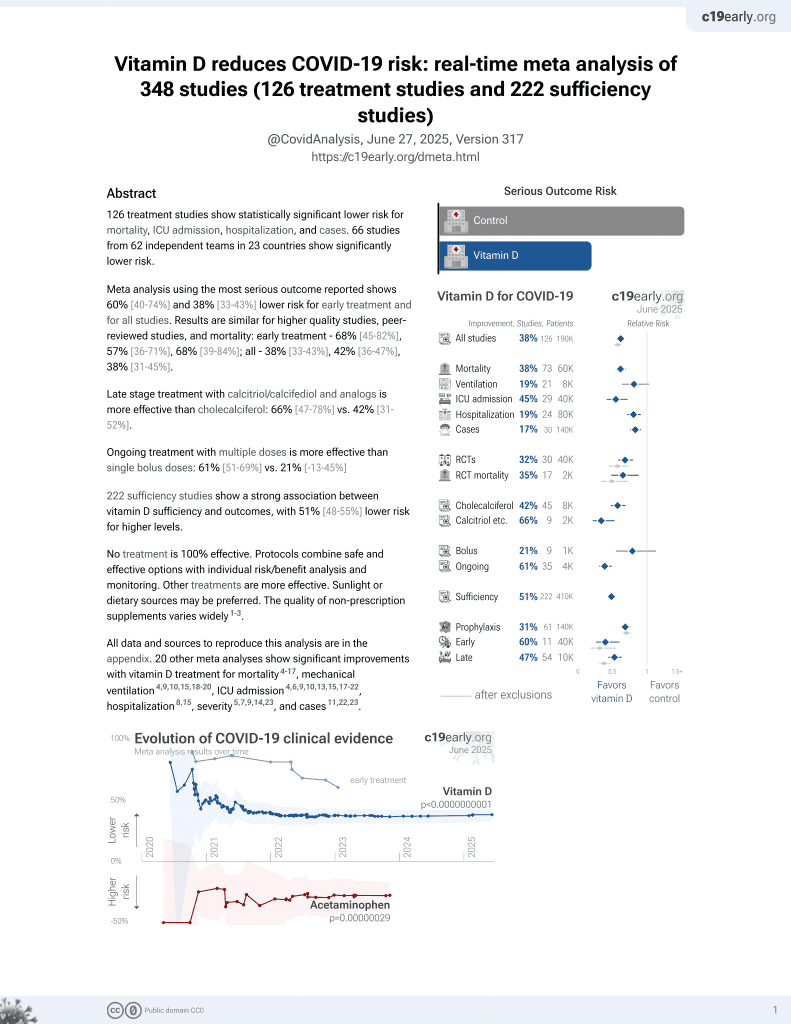
The relationship between vitamin D, biomarkers and clinical outcome in hospitalised Covid-19 patients
et al., Proceedings of the Nutrition Society, doi:10.1017/S0029665121002214, Aug 2021
Vitamin D for COVID-19
8th treatment shown to reduce risk in
October 2020, now with p < 0.00000000001 from 136 studies, recognized in 18 countries.
No treatment is 100% effective. Protocols
combine treatments.
6,300+ studies for
210+ treatments. c19early.org
|
Retrospective 138 COVID-19 hospitalized patients in Ireland, showing increased risk of infiltrates on chest X-ray for patients with vitamin D deficiency, and lower vitamin D levels in patients that died (21.8 nmol/L vs. 37.8 nmol/L, p = 0.054).
This is the 90th of 226 COVID-19 sufficiency studies for vitamin D, which collectively show higher levels reduce risk with p<0.0000000001 (1 in 115,066,047,903,039,356,928 vigintillion).
|
risk of progression, 55.6% lower, OR 0.44, p = 0.03, high D levels (≥30nmol/l) 106, low D levels (<30nmol/l) 32, adjusted per study, inverted to make OR<1 favor high D levels (≥30nmol/l), infiltrates on chest X-ray, multivariable, RR approximated with OR.
|
| Effect extraction follows pre-specified rules prioritizing more serious outcomes. Submit updates |
Breslin et al., 17 Aug 2021, retrospective, Ireland, peer-reviewed, 4 authors.
The relationship between vitamin D, biomarkers and clinical outcome in hospitalised Covid-19 patients
Proceedings of the Nutrition Society, doi:10.1017/s0029665121002214
Previous research has identified an association between low vitamin D status and the risk and severity of acute respiratory infections 1, 2 , leading to suggestion that correction of vitamin D deficiency may improve outcome in COVID-19 patients. This study aimed to elucidate the association between low vitamin D status and adverse clinical outcomes including mortality amongst Covid-19 inpatients. Two-hundred participants were recruited from St. James Hospital, Dublin. Indices of disease severity included duration of hospitalisation, number of signs and symptoms experienced, requirement for oxygen support and ICU admission and mortality. Pearson's and Spearman's correlation tests were used to evaluate the association between serum vitamin D (25(OH)D), interleukin-6 (IL-6), D-dimer, fibrinogen and CD25 levels and disease outcome. Overall, 138 patients (69%) had measured 25(OH)D levels; 23% (n = 32) were classified as 'deficient' (25(OH)D < 30 nmol/L), 25% (n = 34) were classified as 'insufficient' (25(OH)D of 30-49.9 nmol/L) and 52% (n = 72) were classified as 'sufficient' (25(OH)D ≥ 50 nmol/l). No significant correlation was observed between circulating 25(OH)D and age. However, serum 25(OH)D was inversely associated with IL-6 (Β = -0.696, p = 0.036) and D-dimer (Β = -13.71, p = 0.002). High IL-6 levels were associated with an increased likelihood of infiltrates on chest X-ray (OR = 3.615, p = 0.044), while high D-Dimer levels were associated with an increased risk of admission to ICU (OR = 15.304, p = 0.012), and an increased likelihood of requiring oxygen support (OR = 4.035, p = 0.004). Clinically, vitamin D deficiency was associated with an increased risk of infiltrates on chest X-ray (OR = 2.253, p = 0.026). There was also a tendency towards lower vitamin D levels in patients who died (n = 15) than in those who survived (n = 123) (21.8 nmol/L vs. 37.8 nmol/L, p = 0.054). These data suggest that low vitamin D status may be associated with poorer clinical and biometric profiles and increased mortality in hospitalised Covid-19 patients. The association of low vitamin D status with higher IL-6 and higher D-dimer levels, and the association of these biometric markers with more severe clinical outcomes in this and other studies (3, 4) , suggest that these pro-inflammatory and pro-thrombotic mediators may lie at an intermediate point in the causal pathway between low vitamin D status and poorer clinical outcomes including mortality in hospitalised Covid-19 patients.
References
Baktash, Hosack, None, Postgrad Med J
Jain, Chaurasia, None
Martineau, Jolliffe, None, BMJ
Xu, Yang, None, Mol Med Rep
DOI record:
{
"DOI": "10.1017/s0029665121002214",
"ISSN": [
"0029-6651",
"1475-2719"
],
"URL": "http://dx.doi.org/10.1017/S0029665121002214",
"alternative-id": [
"S0029665121002214"
],
"article-number": "E98",
"assertion": [
{
"group": {
"label": "Copyright and Licensing",
"name": "copyright_and_licensing"
},
"label": "Copyright",
"name": "copyright",
"value": "Copyright © The Authors 2021"
}
],
"author": [
{
"affiliation": [],
"family": "Breslin",
"given": "É.",
"sequence": "first"
},
{
"affiliation": [],
"family": "McCartney",
"given": "D.",
"sequence": "additional"
},
{
"affiliation": [],
"family": "NíCheallaigh",
"given": "C.",
"sequence": "additional"
},
{
"affiliation": [],
"family": "Byrne",
"given": "D.",
"sequence": "additional"
}
],
"container-title": "Proceedings of the Nutrition Society",
"container-title-short": "Proc. Nutr. Soc.",
"content-domain": {
"crossmark-restriction": true,
"domain": [
"cambridge.org"
]
},
"created": {
"date-parts": [
[
2021,
8,
17
]
],
"date-time": "2021-08-17T09:18:12Z",
"timestamp": 1629191892000
},
"deposited": {
"date-parts": [
[
2021,
10,
15
]
],
"date-time": "2021-10-15T15:58:20Z",
"timestamp": 1634313500000
},
"indexed": {
"date-parts": [
[
2022,
11,
30
]
],
"date-time": "2022-11-30T07:28:18Z",
"timestamp": 1669793298592
},
"is-referenced-by-count": 2,
"issue": "OCE3",
"issued": {
"date-parts": [
[
2021
]
]
},
"journal-issue": {
"issue": "OCE3",
"published-print": {
"date-parts": [
[
2021
]
]
}
},
"language": "en",
"license": [
{
"URL": "https://www.cambridge.org/core/terms",
"content-version": "unspecified",
"delay-in-days": 228,
"start": {
"date-parts": [
[
2021,
8,
17
]
],
"date-time": "2021-08-17T00:00:00Z",
"timestamp": 1629158400000
}
}
],
"link": [
{
"URL": "https://www.cambridge.org/core/services/aop-cambridge-core/content/view/S0029665121002214",
"content-type": "unspecified",
"content-version": "vor",
"intended-application": "similarity-checking"
}
],
"member": "56",
"original-title": [],
"prefix": "10.1017",
"published": {
"date-parts": [
[
2021
]
]
},
"published-online": {
"date-parts": [
[
2021,
8,
17
]
]
},
"published-print": {
"date-parts": [
[
2021
]
]
},
"publisher": "Cambridge University Press (CUP)",
"reference": [
{
"DOI": "10.1038/s41598-020-77093-z",
"doi-asserted-by": "publisher",
"key": "S0029665121002214_ref3"
},
{
"author": "Baktash",
"first-page": "26",
"journal-title": "Postgrad Med J",
"key": "S0029665121002214_ref4",
"year": "2020"
},
{
"DOI": "10.3892/mmr.2017.7546",
"doi-asserted-by": "publisher",
"key": "S0029665121002214_ref2"
},
{
"DOI": "10.1136/bmj.i6583",
"doi-asserted-by": "publisher",
"key": "S0029665121002214_ref1"
}
],
"reference-count": 4,
"references-count": 4,
"relation": {},
"resource": {
"primary": {
"URL": "https://www.cambridge.org/core/product/identifier/S0029665121002214/type/journal_article"
}
},
"score": 1,
"short-title": [],
"source": "Crossref",
"subject": [
"Nutrition and Dietetics",
"Medicine (miscellaneous)"
],
"subtitle": [],
"title": "The relationship between vitamin D, biomarkers and clinical outcome in hospitalised Covid-19 patients",
"type": "journal-article",
"update-policy": "http://dx.doi.org/10.1017/policypage",
"volume": "80"
}
